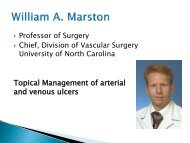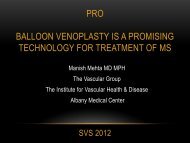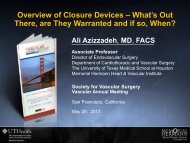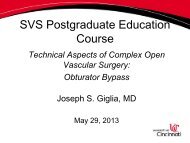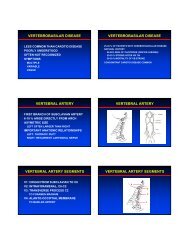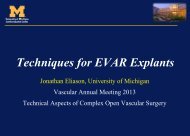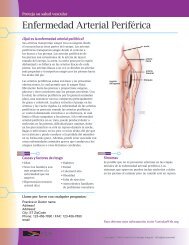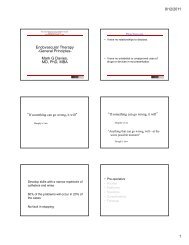EVAR Instructions for Use (IFU): What They Mean ... - VascularWeb
EVAR Instructions for Use (IFU): What They Mean ... - VascularWeb
EVAR Instructions for Use (IFU): What They Mean ... - VascularWeb
You also want an ePaper? Increase the reach of your titles
YUMPU automatically turns print PDFs into web optimized ePapers that Google loves.
<strong>EVAR</strong> <strong>Instructions</strong> <strong>for</strong> <strong>Use</strong> (<strong>IFU</strong>):<br />
<strong>What</strong> <strong>They</strong> <strong>Mean</strong>,<br />
How <strong>They</strong> are Derived,<br />
Outcomes When Ignored<br />
Andres Schanzer, MD<br />
Department of Vascular and Endovascular Surgery<br />
UMass Medical School<br />
June 6, 2012<br />
SVS Postgraduate Course
Disclosures<br />
None
Baseline aortic anatomy is a<br />
key determinant of <strong>EVAR</strong><br />
appropriateness and long<br />
term clinical success.
Endovascular<br />
Candidacy<br />
Anatomic criteria:<br />
Ideal<br />
15-20 mm<br />
18-32 mm<br />
Neck angulation<br />
7-8 mm<br />
30 o<br />
Patent IIA<br />
Minimum Ca+ and tortuosity
Endovascular<br />
Candidacy<br />
32 mm diam<br />
Neck angulation<br />
>45 0<br />
Anatomic Criteria:<br />
deviations from ideal<br />
= chances <strong>for</strong> failure<br />
CIA 22 mm diam<br />
< 7 mm<br />
Moderate/severe Ca++ and tortuosity
27 of 626 Late AAA Rupture s/p <strong>EVAR</strong><br />
§<br />
*Lancet, 2005; Annals of Surgery, 2010.
<strong>EVAR</strong> in 2004<br />
Rupture 2/10/2012<br />
Aortic neck angle 90 degrees
<strong>EVAR</strong> in 2007<br />
Rupture 2/11/2012<br />
Aortic neck 38 mm
In the United States, >70% of<br />
elective repairs of AAA are<br />
per<strong>for</strong>med utilizing <strong>EVAR</strong> *<br />
*Schwarze et al, JVS, 2009.
<strong>Instructions</strong> <strong>for</strong> <strong>Use</strong> (<strong>IFU</strong>)<br />
Guidant<br />
Ancure<br />
Medtronic<br />
AneuRX<br />
Gore<br />
Excluder<br />
Cook<br />
Zenith<br />
Gore Excluder<br />
Low<br />
Permeability<br />
Endologix<br />
Powerlink<br />
Cook<br />
Zenith<br />
Enlarged<br />
Neck<br />
Medtronic<br />
Talent<br />
Endologix<br />
Enlarged<br />
Neck<br />
Gore<br />
Excluder<br />
Enlarged<br />
Neck<br />
Year of Release 1999 1999 2002 2003 2004 2004 2006 2008 2009 2009<br />
Neck Diameter (mm) 18-26 18-25 19-26 18-28 19-26 18-26 18-32 18-32 18-32 19-29<br />
Neck Length (mm) ≥15 ≥10* ≥15 ≥15 ≥15 ≥15 ≥15 ≥10 ≥15 ≥15<br />
Neck Angle (degrees) NS ≤45 ≤60 ≤45 ≤60 ≤60 ≤60 ≤60 ≤60 ≤60<br />
Iliac Fixation Length (mm) ≥20 NS ≥10 ≥15 ≥10 ≥15 ≥15 ≥15 ≥15 ≥10<br />
Iliac Diameter (mm)
<strong>Instructions</strong> <strong>for</strong> <strong>Use</strong> (<strong>IFU</strong>)-Derivation<br />
• Target <strong>IFU</strong> parameters<br />
determined<br />
• Prototype device designed<br />
• Bench top testing<br />
– Mock configurations in models<br />
– Fatigue testing (10 year<br />
simulation)<br />
• Clinical testing<br />
– Phase 1<br />
– Phase 2
<strong>IFU</strong>-Implementation Post Approval<br />
“Nothing…shall be construed to<br />
limit or interfere with the authority<br />
of a health-care practitioner to<br />
prescribe or administer any legally<br />
marketed device to a patient <strong>for</strong> any<br />
condition or disease within a<br />
legitimate health care practitionerpatient<br />
relationship.<br />
*Food and Drug Administration Act of 1997.
<strong>IFU</strong>-Implementation Post Approval
84 patients classified according<br />
to neck <strong>IFU</strong>. Outside <strong>IFU</strong><br />
(30%): “Significantly higher<br />
migration, device-related<br />
complication, and secondary<br />
intervention rates.”
565 patients classified<br />
according to <strong>IFU</strong>. Outside<br />
<strong>IFU</strong> (39%):<br />
“…lower freedom from graftrelated<br />
adverse event”<br />
“…<strong>EVAR</strong> treatment outside<br />
<strong>IFU</strong> should be per<strong>for</strong>med<br />
cautiously, and perhaps not at<br />
all in…candidates <strong>for</strong> open.
238 patients classified<br />
according to neck length (>15,<br />
10-15,
258 patients classified<br />
according to neck <strong>IFU</strong>. Outside<br />
<strong>IFU</strong> (63%): “Significantly<br />
higher rates of early type I<br />
endoleak and intervention (9%<br />
vs. 22%).”
44 open conversions:<br />
“morbidity 55%, mortality 18%”<br />
“…the number of OCs have<br />
increased over the study period.<br />
This trend is likely to continue<br />
because of the rising number of<br />
<strong>EVAR</strong>s…that are per<strong>for</strong>med outside<br />
of instructions <strong>for</strong> use.”
Goals:<br />
To analyze a large, multicenter,<br />
prospectively acquired dataset,<br />
representative of “real world”<br />
<strong>EVAR</strong> practice, containing<br />
extensive baseline and<br />
postoperative anatomic<br />
imaging data.<br />
Schanzer et al, Circulation, 2011.
Goals:<br />
1. Baseline anatomic characteristics<br />
2. Changes in baseline anatomy<br />
3. Incidence rates and predictors of<br />
aortic sac enlargement after <strong>EVAR</strong><br />
Schanzer et al, Circulation, 2011.
Research Design and Methods<br />
• Data Source<br />
– M2S, Incorporated (West Lebanon, NH)*<br />
• Line-item data on all patients who underwent a CT scan<br />
prior to <strong>EVAR</strong> and minimum ≥1 post <strong>EVAR</strong><br />
• Inclusion Criteria<br />
• January 1, 1999 to December 31, 2008<br />
• AAA diameter >30 mm<br />
• If either iliac diameter >20 mm, aortic diameter had to be<br />
>40 mm<br />
• N=10,228 patients<br />
*M2S did not play any role in study design, analysis, or interpretation of the data provided
<strong>Instructions</strong> <strong>for</strong> <strong>Use</strong> (<strong>IFU</strong>)<br />
Guidant<br />
Ancure<br />
Medtronic<br />
AneuRX<br />
Gore<br />
Excluder<br />
Cook<br />
Zenith<br />
Gore Excluder<br />
Low<br />
Permeability<br />
Endologix<br />
Powerlink<br />
Cook<br />
Zenith<br />
Enlarged<br />
Neck<br />
Medtronic<br />
Talent<br />
Endologix<br />
Enlarged<br />
Neck<br />
Gore<br />
Excluder<br />
Enlarged<br />
Neck<br />
Year of Release 1999 1999 2002 2003 2004 2004 2006 2008 2009 2009<br />
Neck Diameter (mm) 18-26 18-25 19-26 18-28 19-26 18-26 18-32 18-32 18-32 19-29<br />
Neck Length (mm) ≥15 ≥10* ≥15 ≥15 ≥15 ≥15 ≥15 ≥10 ≥15 ≥15<br />
Neck Angle (degrees) NS ≤45 ≤60 ≤45 ≤60 ≤60 ≤60 ≤60 ≤60 ≤60<br />
Iliac Fixation Length (mm) ≥20 NS ≥10 ≥15 ≥10 ≥15 ≥15 ≥15 ≥15 ≥10<br />
Iliac Diameter (mm)
<strong>Instructions</strong> <strong>for</strong> <strong>Use</strong> (<strong>IFU</strong>)<br />
• <strong>IFU</strong> Definitions as related to neck anatomy:<br />
1. Conservative <strong>IFU</strong> (most restrictive):<br />
• Neck length >15 mm<br />
• Neck diameter
Research Design and Methods<br />
Primary Outcome:<br />
Aortic Sac Enlargement<br />
(>5mm from baseline)<br />
Schanzer et al, Circulation, 2011.
Results—Baseline Characteristics<br />
Characteristics Number (%)<br />
Patients 10,228<br />
DEMOGRAPHICS<br />
Age, years<br />
Female Gender<br />
AAA Max Diameter
Results—Baseline Characteristics<br />
Characteristics Number (%)<br />
PATIENTS 10,228<br />
INSTRUCTIONS FOR USE<br />
Outside of conservative <strong>IFU</strong><br />
5983 (58.5%)<br />
Outside of liberal <strong>IFU</strong><br />
3178 (31.1%)<br />
Schanzer et al, Circulation, 2011.
Results—Time Trends<br />
Year 1999-2002 2003 2004 2005 2006 2007 2008<br />
Time Dependent Significant Changes<br />
Patients (n) 650 1024 1640 1883 1830 1650 1593<br />
Characteristics 1999-2003 2008 P-value<br />
Age >80 20.0% 26.3%
FREEDOM FROM SAC ENLARGEMENT<br />
1 Year 3 Year 5 Year<br />
Entire Cohort<br />
(n=10,228)<br />
97.2% 83.5% 59.1%
FREEDOM FROM SAC ENLARGEMENT<br />
Outside<br />
Conservative <strong>IFU</strong><br />
Within<br />
Conservative <strong>IFU</strong><br />
1 Year 3 Year 5 Year<br />
96.5% 81.5% 56.5%<br />
97.8% 85.9% 61.0%
FREEDOM FROM SAC ENLARGEMENT<br />
Outside Liberal<br />
<strong>IFU</strong><br />
Within Liberal<br />
<strong>IFU</strong><br />
1 Year 3 Year 5 Year<br />
96.7% 81.5% 57.5%<br />
97.3% 84.9% 59.1%
FREEDOM FROM SAC ENLARGEMENT<br />
OP DATE 1 Year 3 Year 5 Year<br />
1999-2003 98.7% 89.4% 74.3%<br />
2004-2008 96.7% 81.0% 38.4%
Determinants of Sac Enlargement<br />
COX REGRESSION MODEL FOR ANEURYSM SAC ENLARGEMENT<br />
Covariates Hazard Ratio (95% CI) P-Value<br />
Age (years)<br />
Risk Factors:<br />
•Aortic Neck Diameter >28 mm<br />
•Aortic Neck Angle >60 degrees<br />
•Common Iliac Diameter >20 mm<br />
FREEDOM FROM SAC ENLARGEMENT<br />
RISK FACTORS 1 Year 3 Year 5 Year<br />
No Risk Factors 97.7% 86.5% 60.9%<br />
One Risk Factor 99.4% 74.4% 52.9%<br />
Two Risk Factors 92.5% 68.2% 37.1%<br />
Three Risk Factors 81.8% 34.1% --
Discussion<br />
• Even applying the most liberal <strong>IFU</strong> definition,<br />
30% of treated patients do not meet aortic<br />
neck criteria.<br />
• Anatomy deemed acceptable <strong>for</strong> <strong>EVAR</strong> has<br />
continued to liberalize and several of these<br />
factors are independently associated with<br />
aortic aneurysm sac enlargement.
Discussion<br />
• Aortic sac enlargement post <strong>EVAR</strong> occurred in<br />
40% of patients by 5 years.<br />
• In >30% of patients demonstrating aortic sac<br />
enlargement, this was not detected until >3<br />
years postoperatively.
Discussion<br />
• The incidence of aortic sac enlargement after <strong>EVAR</strong><br />
seems to be increasing, not decreasing—despite<br />
increased surgeon experience and improved device<br />
technology.
Conclusions<br />
• Liberalization of the anatomic characteristics<br />
deemed suitable <strong>for</strong> <strong>EVAR</strong> has occurred. This<br />
is associated with a significant increase in the<br />
incidence of aortic sac enlargement thereby<br />
reducing durability of <strong>EVAR</strong> to protect against<br />
AAA rupture.
Are current available<br />
commercial devices<br />
appropriate <strong>for</strong> the increasing<br />
complex anatomy that they are<br />
being applied to?
SVS Postgraduate Session<br />
• Internal Iliac Preservation in the Setting of<br />
Common Iliac Aneurysms<br />
• Short Neck AAA<br />
• Thoracic Aneurysms Extending Proximal to<br />
the Left Subclavian<br />
• Commercial Options on the US Horizon <strong>for</strong><br />
Patients Who Don't Meet <strong>IFU</strong>--Custom and<br />
Off-The-Shelf Solutions
Thank You.



